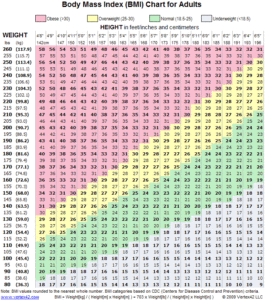The Body Mass Index (BMI) is a calculation of a person’s weight relative to their height. Population studies have shown that at either end of the spectrum, people with very low or high BMI are at greater risk of disease and mortality. Weight categories of underweight, normal weight, overweight, or obese have been set based on BMI.
Where on the BMI scale the dividing lines should be placed between weight categories is the subject of some debate . Also, BMI is limited because it is not an indicator of body composition. BMI does not tell us how much fat or muscle a person has. Therefore, BMI should be interpreted in the context of a person’s health and medical history.
For example, if someone has a BMI of 40 (which would put them in the morbidly obese category) but is a professional athlete or bodybuilder, we would assume that the majority of the weight they carry is in muscle. On the other had, a person with a BMI of 40 who exercises 3 times a week is still likely that they carry their weight in excess fat.
The BMI Formula
The formula for Body Mass Index was devised in the 1830s by Belgian mathematician Adolphe Quetelet. It is defined as the body mass (kg) divided by the square of the body height (m), and is universally expressed in units of “kilograms per metre square” kilograms per square metre (kg/m2).
BMI Chart
Another way to determine your BMI is using a chart! Just locate your height and weight on the chart below and find where they cross to determine your BMI.

The BMI cutoffs and weight categories are:
Below 18.5 Underweight
18.5-24.9 Normal weight
24.5-29.9 Overweight
30 and greater Obese
40 and greater Morbid or extreme obesity
Classification by health risk
Did you know that there is a direct link between chronic disease and obesity? In general, the research shows that higher Body Mass Index (BMI) is a major risk factor for noncommunicable disease such as, cardiovascular, musculoskeletal disorders, diabetes, and some forms of cancer.
The Body Mass Index (BMI):Children
How about children? How do we know if a child is overweight or obese? Children classified as obese are also at greater risk of disease, premature death and disabilities. In children, the BMI cut offs are different and are based on growth charts determined by age and sex. If you suspect a weight issue with your child, it is best to consult a health professional to determine what or if any action is necessary.
The Body Mass Index (BMI): Women vs Men
Did you know that at a given BMI women generally have more fat than men? Body fat content is about 25% for women at normal weight compared to 15% for men. All other things being equal, such as age and exercise levels, women require fewer calories per pound of body weight daily than do men. Female hormones make it easier to convert fat into food.
Is BMI the only way to determine whether a person is obese?
There are several other ways to determine whether a person is obese. Another common method is by waist circumference. The issue with waist circumference is that there is some debate as to where the waist should be defined. Some define waist circumference as the smallest part around the stomach area. Others have defined waist circumference as the circumference around the umbilicus (belly button). Waist circumference has also been defined as the mid-point between the top of the iliac crest (hip bone) and the lowest rib. Use of each of these landmarks will give slight variations in waist circumference. It is thought that a waist circumference over 88 cm (35 inches) in women and 102 cm (40 inches) in men puts a person at greater risk of disease. Population studies have also shown that a high waist circumference is independently associated with a greater risk of mortality.
External Links
